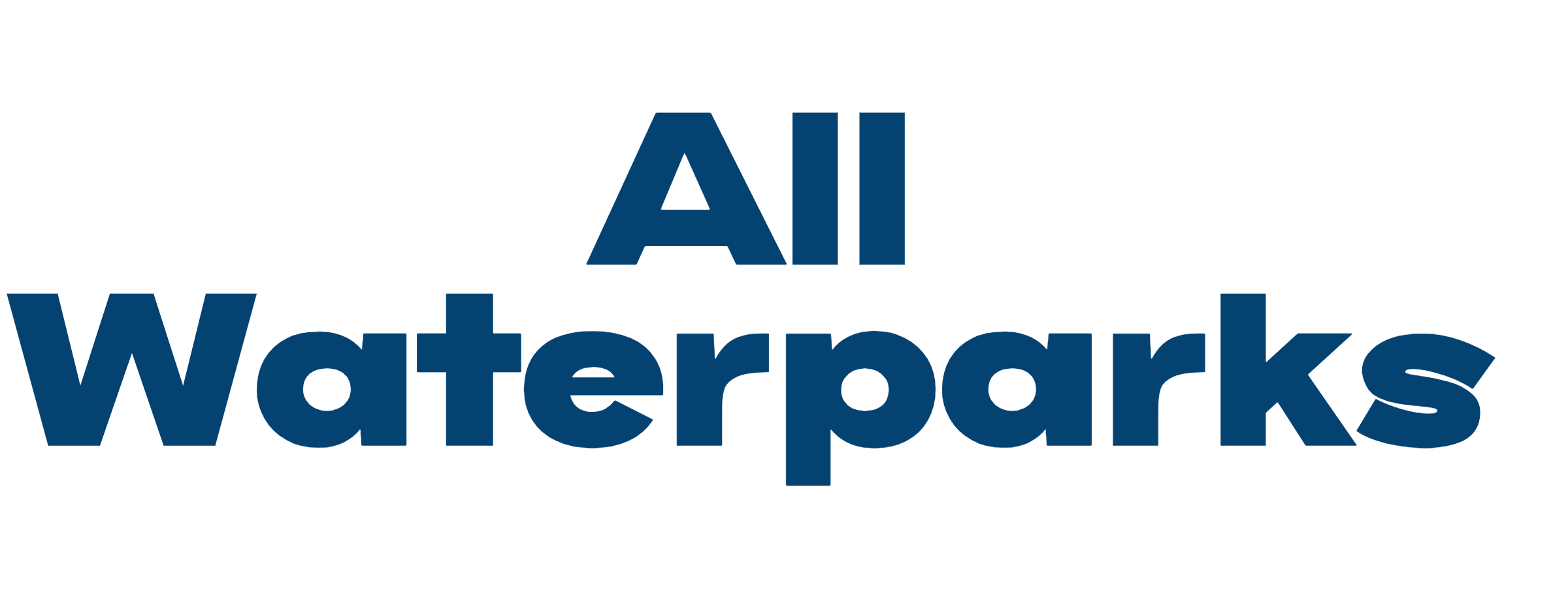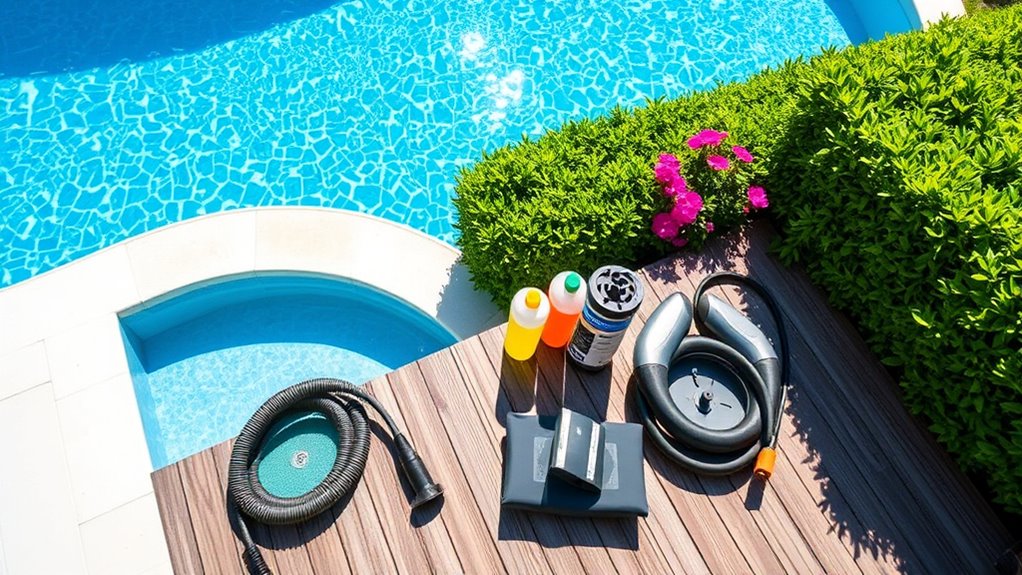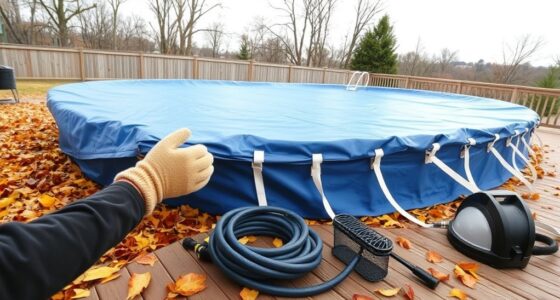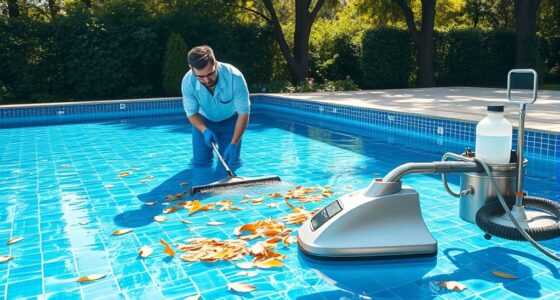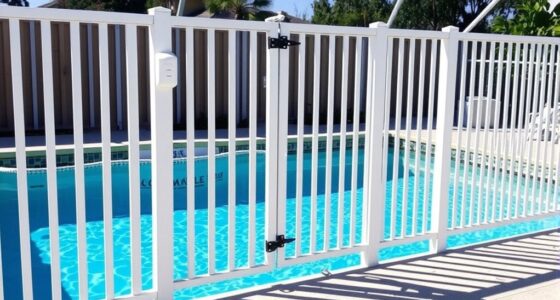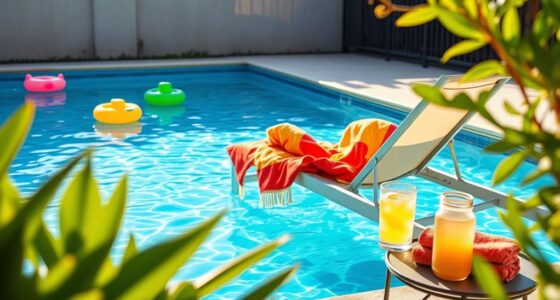To budget for pool maintenance costs, consider initial setup expenses like installation and landscape design, plus ongoing routine tasks such as cleaning, skimming, and water testing. Include expenses for equipment upkeep, repairs, and potential upgrades like heating or lighting. Seasonal closures and early replacements also impact your budget. By planning for these regular costs and unexpected repairs, you can keep your pool in top shape while avoiding surprises—if you pay attention to the details ahead.
Key Takeaways
- Account for initial installation costs, including pool setup, lighting, and landscape design.
- Budget for routine maintenance such as cleaning, skimming supplies, and equipment servicing.
- Plan for periodic equipment replacements, repairs, and system upgrades to prevent costly failures.
- Include water testing and system inspections to maintain water quality and prevent damage.
- Set aside funds for future upgrades like solar heaters, automation, or lighting to optimize long-term costs.
Initial Installation and Setup Expenses
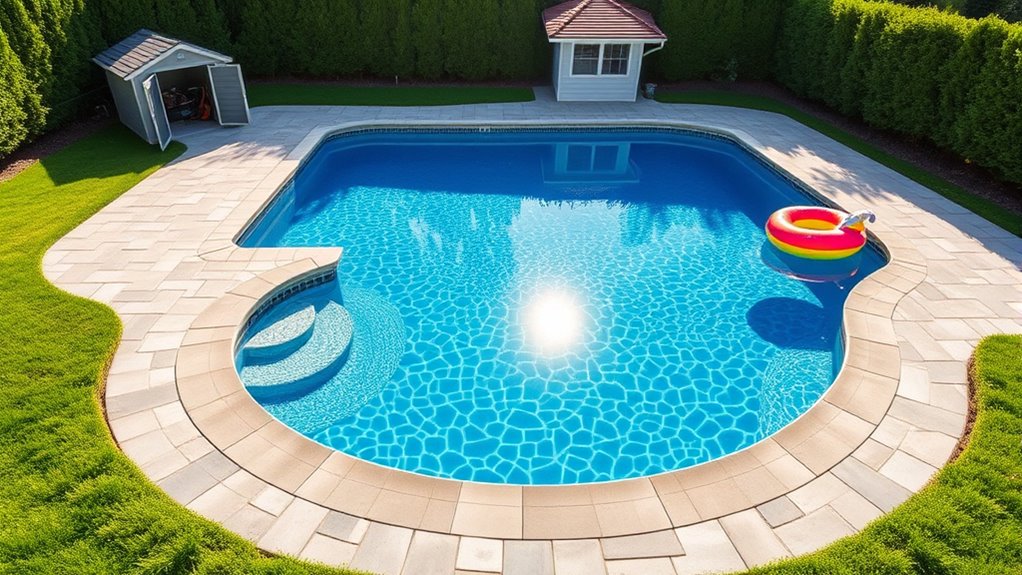
Getting your pool up and running requires a significant initial investment. You’ll need to budget for installation costs, which include pool lighting to enhance nighttime ambiance and safety. High-quality lighting options can vary in price but are essential for a complete setup. Additionally, landscape design plays a crucial role in creating a seamless outdoor environment, adding aesthetic appeal and privacy. Professional landscape planning ensures your pool blends naturally with your yard while reducing future renovation expenses. These setup expenses can add up quickly, depending on the size of your pool and the complexity of your landscape. Investing in good lighting and thoughtful landscape design from the start helps you enjoy a beautiful, functional outdoor space without frequent costly modifications later. Incorporating proper planning can also help optimize the overall project and prevent unexpected costs. To further enhance your setup, consider integrating affordable lighting solutions that balance quality and cost-effectiveness. Moreover, selecting diverse and creative planters for surrounding areas can further elevate your outdoor aesthetic and create a cohesive design.
Routine Cleaning and Skimming Costs
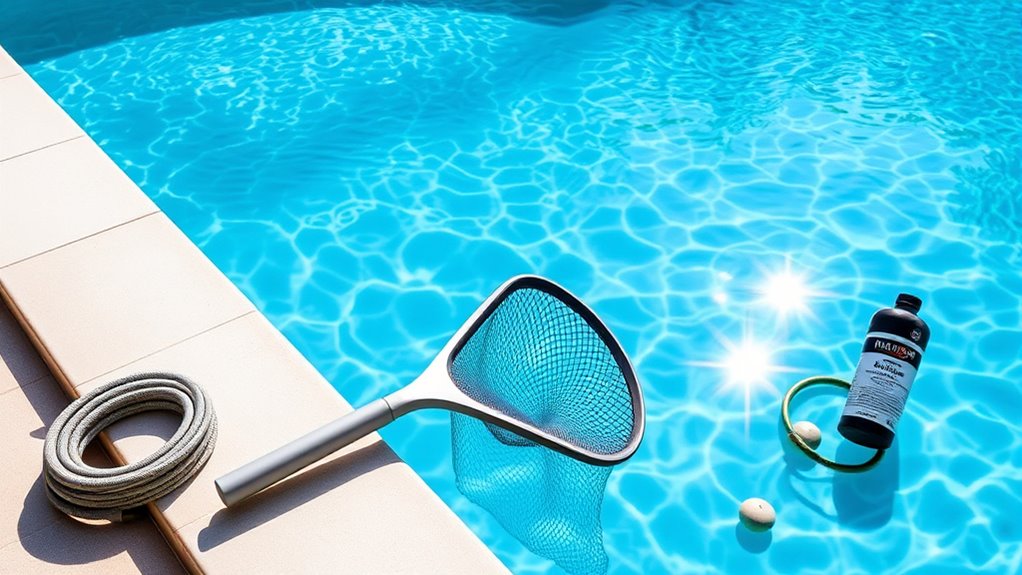
You’ll need to clean and skim your pool regularly to keep the water clear and safe. The frequency depends on factors like weather and usage, and you’ll also face equipment maintenance fees. Additionally, the cost of skimming supplies adds up over time, so budgeting for these routine tasks is essential. Implementing proper pool safety management ensures that your equipment functions effectively and reduces potential hazards. Regular maintenance also helps prevent water contamination, which can be costly to address later. Incorporating vetted equipment options can improve the efficiency and longevity of your pool maintenance routine.
Cleaning Frequency Needs
How often should you clean your pool to keep it sparkling and safe? Regular skimming and brushing are essential, especially during peak usage or after storms. Aim to skim daily to remove debris and prevent algae buildup. Weekly deep cleaning includes brushing the walls and vacuuming the floor. If you have solar heaters or pool lighting, check and clean these components regularly, as debris can obstruct their performance. Proper cleaning guarantees your solar heaters operate efficiently, reducing energy costs. Additionally, maintaining clear water improves the effectiveness of lighting, making your pool safer and more inviting at night. Consistent cleaning reduces the need for chemical treatments and prolongs equipment lifespan, saving you money in the long run. Regular use of a robot vacuum can help automate this process, ensuring thorough cleaning without extra effort. Staying on top of routine maintenance keeps your pool beautiful and functional year-round. Incorporating regular maintenance routines can also help identify potential issues early before they become costly repairs. Furthermore, proper cleaning techniques can help preserve the integrity of pool surfaces, extending their lifespan and maintaining a pristine appearance.
Equipment Maintenance Fees
Regular cleaning and skimming are essential for maintaining your pool’s equipment and preventing costly repairs. Consistent removal of debris protects filters and pumps, ensuring energy savings and prolonging equipment life. Neglecting routine tasks can void warranty coverage, leading to expensive replacements. To visualize, here’s a snapshot of typical costs:
| Service Type | Estimated Annual Cost |
|---|---|
| Skimming and debris removal | $100 – $200 |
| Filter cleaning | $50 – $150 |
| Pump maintenance | $75 – $200 |
| Professional inspections | $100 – $300 |
Sticking to routine cleaning not only preserves your equipment but also helps you avoid unexpected expenses, keeping your pool running efficiently. Maintaining proper pool maintenance routines is vital for long-term cost savings and optimal performance. Additionally, following manufacturer guidelines can help prevent equipment failure and extend the lifespan of your pool systems. Proper preventive maintenance can further reduce the likelihood of unexpected breakdowns and costly repairs. Incorporating regular inspections and timely upgrades can also ensure your system remains efficient and reliable over time.
Cost of Skimming Supplies
Skimming supplies are a small but crucial part of maintaining your pool’s cleanliness and preventing debris buildup. These tools, like skimmer nets and floating skimmers, are indispensable for effective debris removal. The cost of skimming supplies is relatively low, typically ranging from $10 to $30 per item, depending on quality. You may need multiple nets or replacement parts over the season. Regular use of these supplies keeps leaves, insects, and other debris from sinking and causing water quality issues. Investing in durable skimming supplies can save you money in the long run by reducing the need for more extensive cleaning or chemical treatments. Properly maintaining debris removal tools ensures their effectiveness and longevity. Additionally, choosing high-quality equipment can improve efficiency and durability, making routine maintenance easier and more effective. Budgeting for these routine costs ensures your pool stays clean, clear, and inviting all season long.
Water Testing and Chemical Balancing
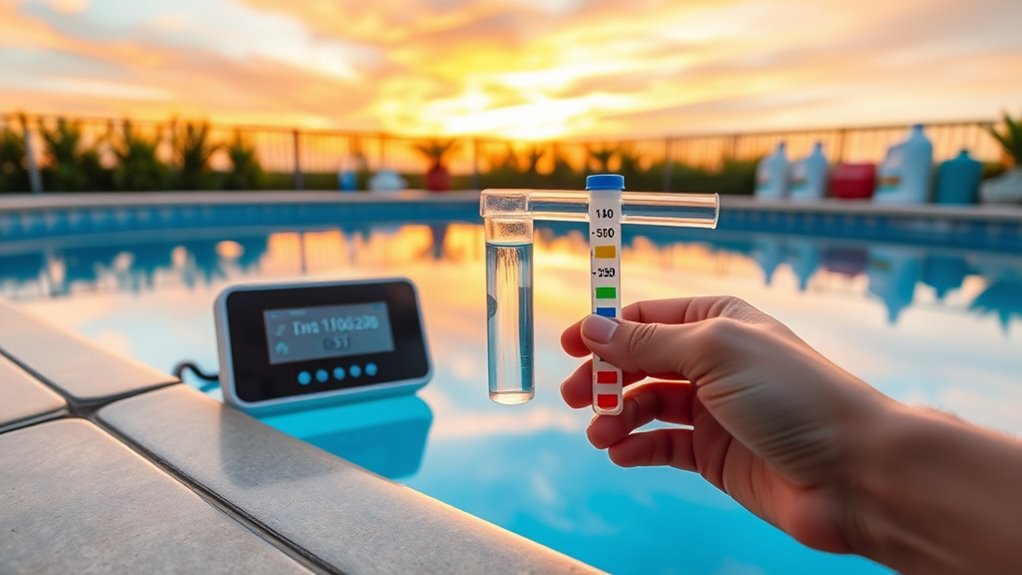
Maintaining proper water quality is essential for a safe and enjoyable swimming experience, which is why testing and balancing your pool’s chemicals should be a regular part of your maintenance routine. Proper chemical balance prevents algae growth, corrosion, and skin irritation. Regular testing ensures your water’s pH, chlorine, alkalinity, and stabilizer levels stay within ideal ranges. Implementing water testing procedures similar to those used in vehicle tuning, such as ECU remapping and exhaust adjustments, helps optimize overall pool performance. Staying informed about home security systems can also provide peace of mind while you focus on your pool maintenance routine. Additionally, understanding astrological signs can sometimes influence your approach to routine tasks, encouraging patience and consistency in maintenance efforts. Using test kits specifically designed for pools will give you more accurate readings and improve your ability to maintain proper chemical balance. Investing in reliable pool testing equipment can also reduce guesswork and ensure more precise adjustments. Staying consistent with testing schedules and adjustments will help you maintain a clear, healthy pool and avoid costly repairs down the line.
Filtration System Maintenance
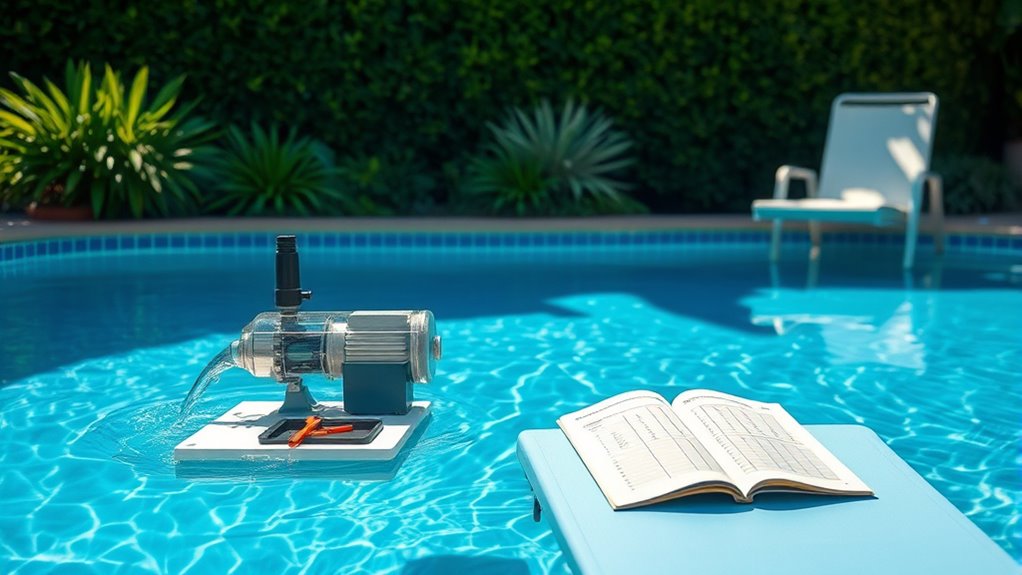
Maintaining your pool’s filtration system is essential for clear, healthy water. You’ll need to follow a regular filter replacement schedule and keep the pump in good shape with proper maintenance. Regular cleaning and inspection help prevent costly repairs and keep your system running smoothly. Additionally, understanding the importance of necessary cookies in website functionality highlights how proper system management can optimize performance. Incorporating routine checks of your system’s filter maintenance can further extend its lifespan and ensure optimal water quality. Using high-quality filtration technologies like HEPA filters can also improve the efficiency of your pool’s water purification process. Studies have shown that implementing advanced hydrocolloid materials in filtration can enhance impurity removal. Recognizing the father and daughter bond can remind pool owners to take pride in creating a safe and enjoyable environment for family moments.
Filter Replacement Schedule
Regularly replacing your pool filter is essential to keep your filtration system running smoothly and your water clean. A well-maintained filter ensures proper water circulation, which helps maintain the chemical balance necessary for safe swimming. Depending on your pool type and usage, filters typically need replacement every 1 to 3 years. Keep an eye on pressure gauges; if pressure rises markedly, it indicates your filter may be clogged and needs replacing sooner. Regular replacement prevents debris buildup that hampers water flow and reduces chemical effectiveness. By sticking to a filter replacement schedule, you’ll save on energy costs and extend the life of your filtration system. Proper maintenance ultimately keeps your pool water clear, safe, and inviting all season long.
Pump Maintenance Tips
A clean, well-functioning pump is essential to keeping your pool water clear and properly circulated. To maintain ideal pump efficiency, regularly check for debris that might clog the impeller or strain the motor. Ensure the motor is properly lubricated; many pumps have lubrication points that need annual attention. Use the manufacturer-recommended lubricant to prevent overheating and reduce wear. Keep an eye on the pump’s pressure gauge—if pressure drops or rises unexpectedly, it could indicate a problem. Also, inspect the pump’s seals and connections for leaks. Regular maintenance boosts pump performance and extends its lifespan, saving you money in the long run. Staying proactive with pump lubrication and debris removal keeps your filtration system running smoothly.
Cleaning and Inspection
How often should you inspect and clean your pool’s filtration system? You should check it weekly to guarantee peak performance. Regular cleaning prevents buildup that can cause chemical imbalance and algae growth. When inspecting, look for debris clogging the filter or signs of wear. To keep your system running smoothly, consider these steps:
- Remove and rinse the filter cartridge to clear out dirt and algae spores.
- Check the pressure gauge—if it’s high, backwash or clean the filter.
- Inspect for cracks or leaks that could reduce filtration efficiency.
Proper maintenance keeps your water clear and balanced, reducing chemical costs and preventing algae blooms. Regular cleaning and inspection ensure your filtration system functions effectively, saving you money and effort in the long run.
Heating and Cooling Expenses
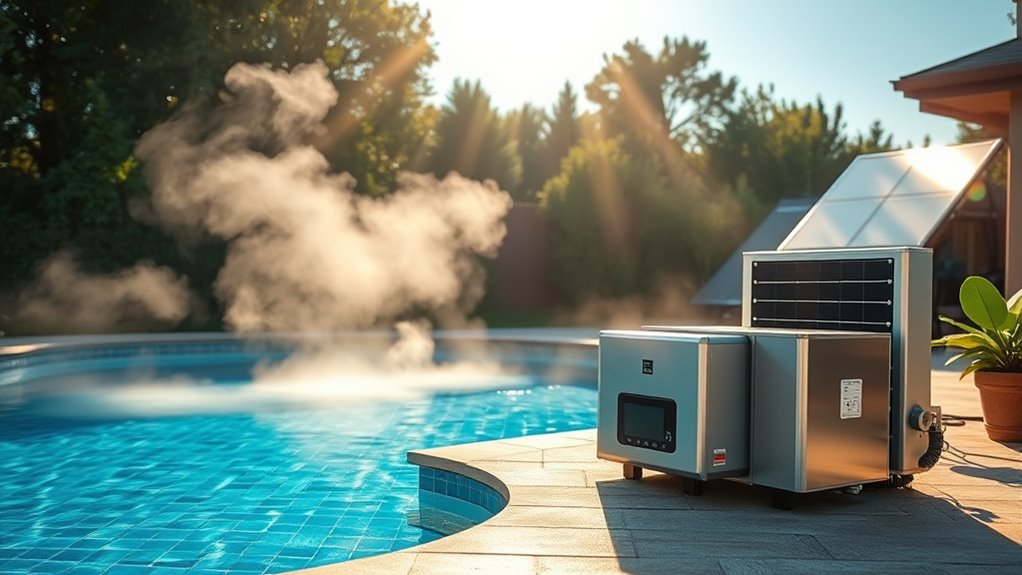
Have you ever wondered just how much heating and cooling your pool costs throughout the year? The good news is that choosing the right system can make a big difference. Solar heating is an eco-friendly, cost-effective option that uses sunlight to warm your pool, reducing energy bills considerably. If you prefer a more consistent temperature, a heat pump selection might be ideal, as it efficiently extracts heat from the air to maintain comfortable water temperatures. Keep in mind that energy costs can vary depending on your climate and usage patterns. Regular maintenance of your heating system guarantees peak performance and longevity. By understanding these options, you can better budget for ongoing expenses and enjoy a comfortably warm pool all season long.
Pool Cover and Safety Equipment Costs
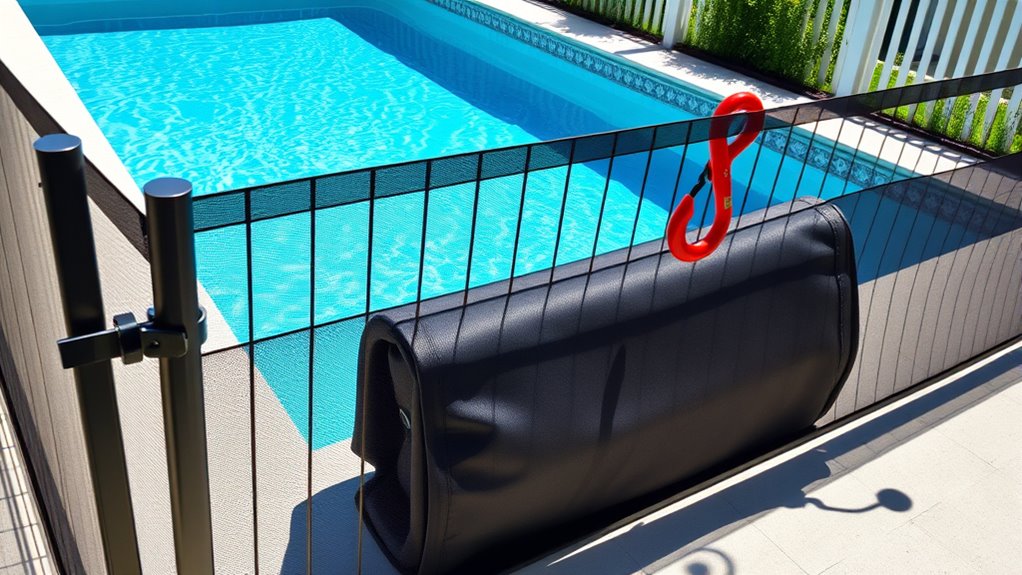
Investing in a quality pool cover and safety equipment can substantially reduce your ongoing expenses and enhance your pool’s safety. Automatic covers are convenient and help keep debris out, lowering cleaning costs. Safety fencing creates a physical barrier, preventing accidents and unauthorized access. Visualize these improvements with:
- A sleek automatic cover smoothly sealing your pool at the push of a button.
- Sturdy safety fencing surrounding your pool, providing peace of mind.
- A secure latch on your cover, ensuring it’s always properly closed.
These investments not only protect loved ones but also help maintain water quality and reduce evaporation. While initial costs may seem high, the long-term savings and safety benefits make them worthwhile. Properly budget for these essential safety features to safeguard your investment and loved ones.
Regular Inspection and Repairs
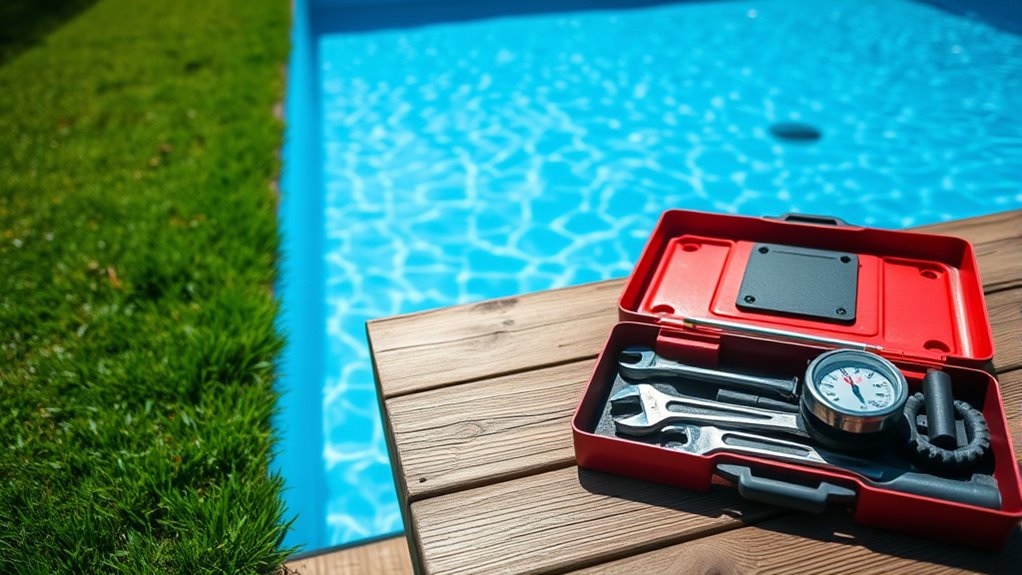
Regular inspections are essential to keep your pool in top shape. By performing routine visual checks, you can catch issues early before they become costly repairs. Addressing problems promptly guarantees your pool stays safe and ready for use.
Routine Visual Checks
How often do you check your pool for issues? Regular visual checks are essential to catch problems early. Imagine walking around your pool and noticing:
- Discolored patches or slimy algae starting to form on the surface or walls.
- Unusual chemical spills that could disrupt the water balance.
- Debris or buildup near the skimmer or drain that could clog filters.
Swift Problem Resolution
Catching issues early through frequent visual checks makes it easier to address problems before they escalate. When you spot a leak, cloudy water, or equipment malfunction quickly, you can prevent costly emergency repairs. Prompt action helps you maintain your pool’s safety and functionality, saving you money in the long run. Keep in mind that regular inspections can also ensure your equipment stays covered under warranty, reducing repair costs if something breaks unexpectedly. When an emergency repair is needed, acting swiftly minimizes damage and downtime. Staying proactive allows you to schedule repairs at your convenience and avoid last-minute expenses. By addressing problems early, you keep your pool in top condition while managing maintenance costs effectively.
Seasonal Closing and Opening Procedures
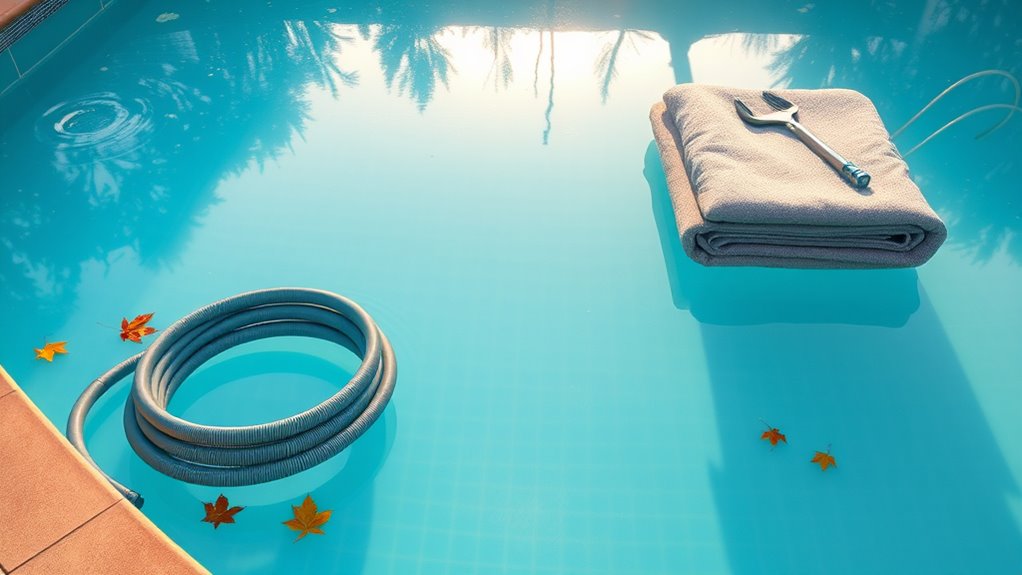
As the swimming season comes to an end, properly closing your pool is essential to protect it from damage during the off-season. Start with winterizing procedures: lower the water level, clean the filter, and add winter chemicals to prevent algae growth. Next, cover the pool securely to keep debris out and prevent damage from winter weather. Finally, drain equipment like pumps and filters if advised by manufacturer instructions. When it’s time to reopen, follow seasonal reopening steps: remove the cover carefully, refill the pool, and run the pump to circulate chemicals. Inspect equipment for damage and perform necessary repairs. Properly closing and opening your pool ensures it remains in good condition, reducing costly repairs and making your seasonal transition smoother.
Long-term Equipment Replacement
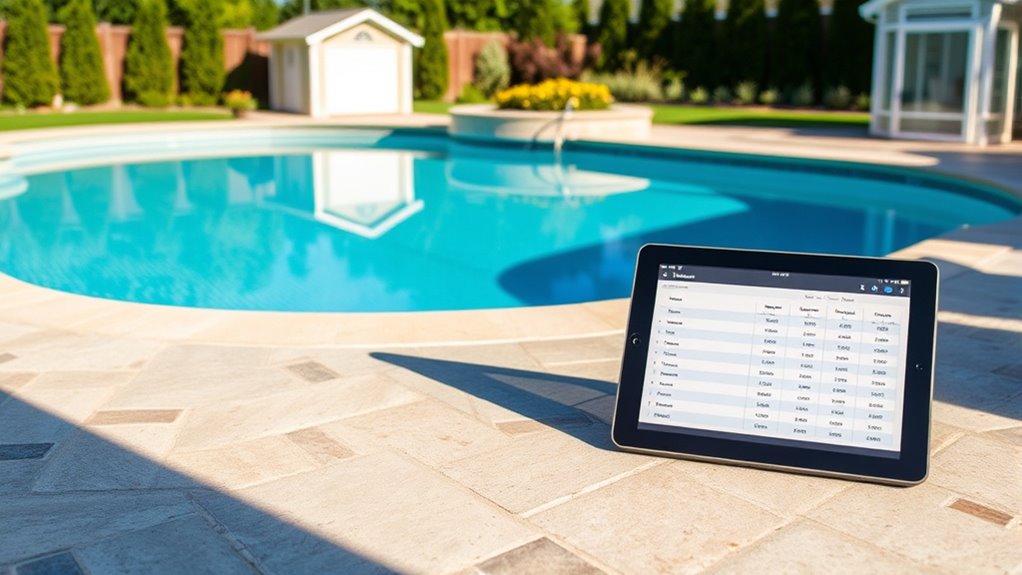
Over time, some pool equipment will wear out or become less efficient, making replacement necessary to keep your pool running smoothly. Solar heating systems, for example, may degrade or lose effectiveness, requiring eventual upgrade to maintain energy efficiency. Similarly, outdoor lighting fixtures can burn out or become outdated, affecting safety and ambiance. Planning for these replacements guarantees your pool remains functional and enjoyable. Budgeting for long-term equipment costs means setting aside funds for periodic upgrades, which can prevent sudden, costly failures. Regular inspections help identify when components like solar heaters or outdoor lights need attention. By staying proactive, you’ll extend the lifespan of your equipment, optimize energy use, and keep your backyard inviting and safe all season long.
Additional Features and Upgrades
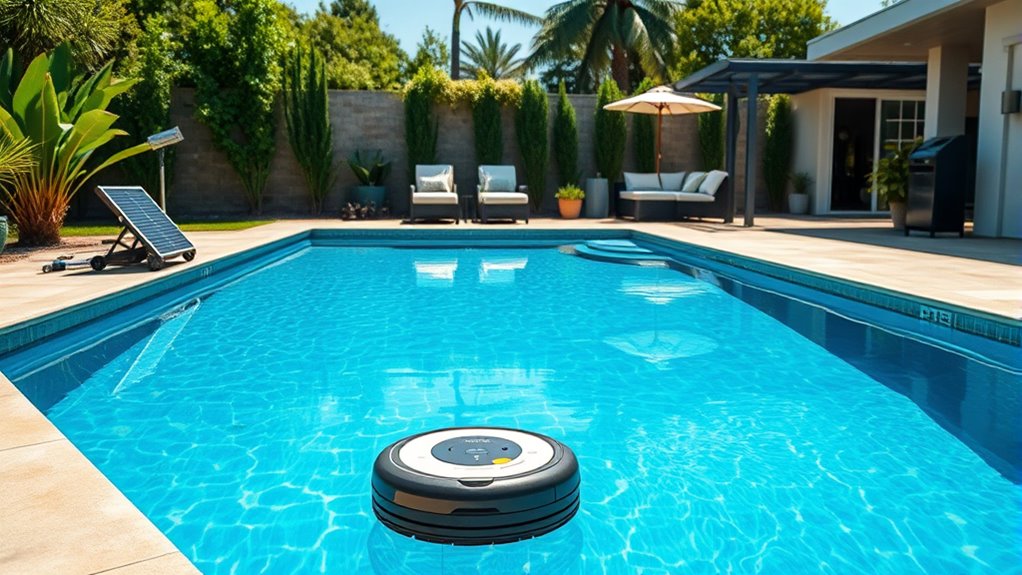
Adding new features and upgrades can substantially enhance your pool experience, but it’s important to contemplate their long-term costs. For example, installing solar heating can extend your swimming season and reduce energy bills, but initial setup might be costly. Upgrading to a saltwater system offers softer water and less chemical use, yet maintenance and replacement parts add ongoing expenses. Consider these upgrades:
- Installing solar panels to harness sunlight and cut heating costs.
- Switching to a saltwater chlorination system for easier maintenance.
- Adding automation features like automated cleaners and temperature controls.
While these upgrades improve convenience and comfort, they also require budgeting for installation, maintenance, and potential repairs over time. Planning ahead ensures you enjoy the benefits without unexpected expenses derailing your budget.
Frequently Asked Questions
What Are the Hidden Costs Associated With Pool Ownership?
When considering hidden costs of pool ownership, you might not realize expenses like ongoing pool chemical costs, which can add up over time. Seasonal cleaning schedules also require regular effort and supplies, often overlooked in initial budgets. Unexpected repairs or equipment replacements can catch you off guard too. Staying aware of these hidden costs helps you plan better, ensuring your pool remains enjoyable without surprising expenses draining your finances.
How Can I Reduce Ongoing Maintenance Expenses?
To cut ongoing maintenance expenses, prioritize regular pool safety checks and proper seasonal opening procedures. Keep your pool clean and balanced to prevent costly repairs down the line. Use energy-efficient equipment, like LED lights and variable-speed pumps, to lower electricity costs. Cover your pool when not in use to reduce water evaporation and chemical use. These steps help maintain your pool efficiently while keeping expenses manageable.
Are There Eco-Friendly Options to Lower Operating Costs?
You can lower operating costs by choosing eco-friendly options like eco-friendly filtration systems that use less energy and water. Installing solar heating helps reduce energy expenses while keeping your pool warm naturally. These upgrades not only cut your bills but also lessen your environmental impact. By investing in eco-friendly filtration and solar heating, you make your pool more sustainable and cost-effective over time.
What Insurance Coverage Is Recommended for Pool-Related Damages?
When considering pool repair, it’s vital to have the right insurance policies in place. You should look for coverage that protects against damages from accidents, vandalism, and natural disasters. A thorough policy can help cover costs related to pool-related damages, ensuring you’re financially protected. Review your current insurance and talk to your agent to add or adjust coverage, so you’re fully prepared for any unforeseen pool repair expenses.
How Does Pool Size Affect Overall Maintenance Budget?
Did you know larger pools can increase your maintenance budget by up to 50%? Your pool size directly impacts costs since bigger pools require more chemicals, filtration, and cleaning. As the size grows, so does the effort and expenses to keep it pristine. You’ll need to allocate a bigger maintenance budget to cover these ongoing needs, ensuring your pool stays inviting and safe without surprises.
Conclusion
Owning a pool is like tending a garden—you must nurture it regularly to see it thrive. Budgeting for initial setup, ongoing maintenance, and upgrades keeps your oasis sparkling and inviting. Think of each expense as a drop of water nurturing your backyard paradise; neglect one, and the whole pond risks stagnation. Stay proactive with your costs, and your pool will remain a shining centerpiece, inviting you to relax and enjoy for years to come.
